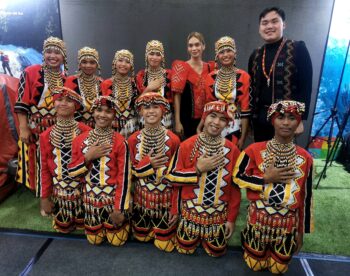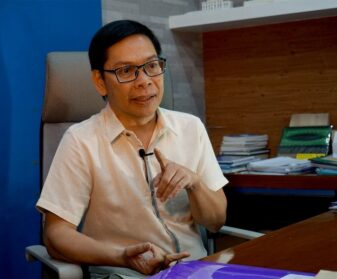
QUEZON CITY (MindaNews / 26 Sept) — Iran is in the spotlight today, with hundreds of thousands protesting over the death of a young woman while under the custody of the morality police. Why was Mahsa Amini, a 22-year-old woman, detained? Because her hair showed under her hijab (veil). In protests, Iranian women, young and old, took to the streets – supported by men. They took off their hijab, many burned their veils publicly, sparking protests all over Iran.
After the 1979 Islamic Revolution in Iran, so-called “Guidance Patrols” were created to police compliance to the norms of Sharia, particularly a dress code requiring all women to wear the hijab and loose-fitting clothing in public to disguise their figures. The morality police had the power to detain women who wore too much make up or showed too much hair or tight clothes. Punishment included prison or flogging.
Iranian President Ebrahim Raisi, while attending the United Nations General Assembly in New York, said he had ordered an investigation of Amini’s death while warning the protesters that “acts of chaos” were not acceptable. A Senior Member of Parliament, Jalal Rashidi Koochi, has publicly criticized the morality police for using force.
At least seven persons have reportedly been killed since the protests started.
Why has the hijab become THE more important aspect of Islam instead of charity? Charity, after all, is one of the five pillars of the faith.
Does the Holy Quran itself make the hijab a religious obligation for all Muslim women? I am not an Islamic scholar so I turn to those who have researched the issue. According to Dr. Asma Lambaret, the term “hijab” is reiterated seven times in the Qur’an referring each time exactly to the same meaning. “Hijab” means curtain, separation, wall and, in other words, anything that hides, masks and protects something[i]. She is the Director of Studies and Research Center on Women’s Issues in Islam of (Rabita Mohammadia des Ulemas), supported by King Mohammad VI.
Dr. Lambaret notes: “the verse that has been most often used to prove the “obligation” of veiling for women and that mentions the term Hijab is the following: ” O you who have believed, do not enter the houses of the Prophet except when you are permitted for a meal… And when you ask [his wives] for something, ask them from behind a separation (Hijab)” Quran 33; 53.
“As indicated here, the Hijab concerns only the wives of the Prophet and meets a circumstantial requirement in order to respect the private life of the Prophet. Besides, it does not represent, in any way, a particular model of clothing. The essence of this requirement aimed, mainly, to educate Arabs of that time to respect the privacy of people and good manners.”
On clothing, the Quran has three references enjoining women to be modest and not draw attention to their sexuality. In Sura 24:30-31, the reference is to let their head covering cover their necklines and not reveal their charms. Do note that it does not mandate the use of a head scarf. However, all women in the Middle East used veils in those days to protect them from the sun and sand. Also note that in those days, women of ill-repute would bare their breasts and legs to attract men. Thus, it made sense that women of faith be enjoined to cover their bodies.
Today, however, women’s veils are occupying center stage instead of the plight of the Muslim refugees, of Palestine, of the Rohingya, the restriction of Afghan girls from going to school, among many.
If my mother, former Senator Santanina T. Rasul, were still in public office, she would surely stand up for the rights of Muslim women in Iran and everywhere else, including the Philippines. While she fought for the right of Muslim women to use the hijab in public and not be discriminated against, she also defended our right not to wear the hijab. It is our choice.
In our latest episode on “She Talks Peace,” my sister Salma and I shared stories about our mom. We recalled her remarkable life as an educator and advocate for adult literacy, a Muslim senator, and a trailblazer in promoting and protecting the rights of Filipino women.
Mother of Illiterates. Senator Rasul was mother not only to the six Rasul siblings, but also to the Philippines’ adult illiterates. Recognizing the low literacy rates in Muslim Mindanao and working in her own capacity in civil society — long before civil society was established in Muslim Mindanao — she rose to the challenge of teaching adult illiterates in underserved communities how to read and write. With our help, she developed the Magbassa Kita reading manual which employed the phono syllabic method of teaching adults to read. As word of her effective method spread, organizations began reaching out to ask her to teach in their communities. Shout out to Marlen Ronquillo (Manila Times) who wrote last week about Mama and her advocacy for education. https://www.manilatimes.net/2022/09/25/opinion/columns/downhill-from-there-for-education-sector/1859675
Observing that the Philippine educational system is geared toward children and alienating for adults, Senator Rasul personally went to the barangay to teach. She also trained people from the barangays to become literacy teachers, so the program could continue after she left. Magbassa Kita would later become a nationwide program, prompting President Corazon Aquino to make her a senatorial candidate.
A Fair Lawmaker. Senator Rasul was the first Muslim woman to be elected senator, the first Muslim Senator to be re-elected, and the last Muslim Senator from Muslim Mindanao. This is a huge feat, considering that the Philippines’ Muslim population is no greater than 10%. However, she was acutely aware that she was a senator for all Filipinos, regardless of religion, creed, or association.
During her career in the Senate, countless civil servants approached her and complained that they were being eased out of their positions because they were appointed during the Marcos years and seen as sympathizers. Seeing how this affected hundreds of thousands of innocent civil servants, Senator Rasul launched hearings to look into the situation and came up with a bill—which later became known as the “Rasul Law”— to stop the practice.
Women’s Rights Advocate. The celebration of women’s month in the Philippines can be attributed to Senator Rasul. She moved to make allies in both the Senate, and the House of Representatives to pass the bill and make it a law.
Senator Rasul notably authored the Women in Development and Nation-building Act, among other acts that aimed to empower women. Very much ahead of her time, she penned this powerful piece of legislation that required to set aside a certain percentage of the budget for projects that capacitate women. Later, the late Senator Leticia Ramos-Shahani fixed the percentage at 5% in the Magna Carta for Women, but it was Senator Rasul who first put it on the table.
Lessons Learned. We have inherited much of our ethos from our mother. If you want to know about the lessons we have learned from Senator Rasul – like the meaning of a cracked porcelain plate – listen to “She Talks Peace”.
Please Click, Play and Listen on Spotify:
Apple Podcasts:
(MindaViews is the opinion section of MindaNews. Amina Rasul is the President of the Philippine Center for Islam and Democracy, an advocate for Mindanao and the Bangsamoro, peace, human rights, and democracy)







